Original link: https://shyrz.me/news-24-intrinsic-motivation/


22·11·08 Issue 24
Ladies and gentlemen, see the letter as your face.
This issue, “The Science of Motivation: How to Gain and Maintain Motivation,” introduces a recent popular paper on the Black Death and genetics, revealing the relationship between this historically-changing plague and humanity; the selected essay “Successful” Are writers creative geniuses or literary laborers? With the life of Edgar Allan Poe and Verne as an introduction, it points out two directions in the artist’s career, and at the same time dialectically looks at the common phenomenon of reference and even plagiarism in the field of art.
Hope that inspires.



Refind : 7 links from the cluttered Internet based on your interests every day to make you smarter. Loved by up to 100,000 users.
(Clicking on the link above helps me run better, and I receive a modest sponsorship for every valid click of yours. Refind is also one of my main sources of information, if you’re interested in trying it out My promotion link registration.)

The Science of Motivation: How to Get and Stay Motivated
→ Original link: https://nesslabs.com/science-of-motivation — Hannah Rose / NessLab
How to get back your lost motivation? A lot of people will buy a motivational book or watch some motivational videos thinking it will help them find their magic. But these tricks are unlikely to succeed.
The reality is that momentum only starts to build again when we take our first steps and gain some momentum in the mission. In Lao Tzu’s words: “A journey of a thousand miles begins with a single step.” Motivation is to start and keep taking action to make sure we get back on track when we fall behind.
why we do this
There are two types of motivation: intrinsic motivation and extrinsic motivation. We experience intrinsic motivation when interest or enjoyment in an activity comes from within. For example, a violinist might want to improve his music because of the intense joy that comes from playing, not in pursuit of fame or awards.
Thus, intrinsic motivation associated with doing something you enjoy is strongly associated with ongoing behavioral changes, improved well-being, because the activity itself brings joy.
With intrinsic motivation, activities have intrinsic rewards. Researchers in organizational psychology point out : “Intrinsic motivation is the key to persistence at work”. If you enjoy what you do, activities and goals will collide, leading to increased interest and work experience.
Instead, extrinsic motivation is driven by external influences. You may want to progress in your career, earn more money, be recognized at work, or be exempt from sanctions. In extrinsic motivation, your desired outcome is dissociated from the activities you perform to achieve it, making it more likely that motivation will decline.
But that doesn’t mean extrinsic motivation is bad: the secret to motivation is a little more complicated than that.
elements of motivation
Motivation has been studied for many years, and one of the most popular schools of thought is self-determination theory. This theory uses an empirical approach to emphasize the importance of self-regulation, the process of accepting social values before they are transformed into self-values and self-motivation.
Writing in the American Psychologist, Richard Ryan and Edward Deci highlight three innate psychological needs that must be met in order to improve self-motivation and mental health: competence, Autonomy and Relevance.
Our intrinsic motivation is stronger if we feel that we are competent for a certain behavior, whether due to feedback, communication, or reward. However, only when we have a sense of autonomy for the behavior.
Relevance tends to be more related to extrinsic motivation. If a behavior is valued by a boss, client, or friend, we feel a sense of connection with it, which leads to the internalization of extrinsic motivation.
Thus, Self-Determination Theory proves that our psychological needs must be met for self-regulation to occur so that intrinsic and extrinsic motivation can be maintained.
Why is it so hard to stay motivated?
We like to think of ourselves as curious learners. But many people have experienced a sense of apathy at some point in their personal or professional lives. Whether we’re stuck in a stagnant job or lying unconscious on the couch day in and day out, a lack of motivation affects us all.
There are many reasons for the lack of motivation. Maybe the challenge feels too hard. If stepping out of your comfort zone causes intense fear or anxiety, you may lose the motivation you once had and give up on tasks.
It’s not just goals that are too difficult that lead to lack of motivation. If a goal is too easy or doesn’t lead to an appropriate reward, you may lack motivation to pursue it, even though it is achievable.
Likewise, if you set goals that don’t work for you, you may not be able to self-regulate and see how the goals relate to you. Without self-regulation, neither intrinsic nor extrinsic motivation exists, and you cannot manage to stay motivated.
In some cases, an unclear desire may hinder your pursuit. You probably know you’re unhappy with your current job, but aren’t sure where to start driving career change .
Whether your motivation for change is internal or external, you cannot sustain momentum without a clear purpose .
As you can see, there are a number of reasons why your power slump can occur. Fortunately, there are some ways to gain and maintain motivation. It’s important that you get back on track as quickly as possible when you realize your lack of motivation. Strive to “never fail twice in a row” by taking action on any underpowered situation and not letting it continue.
Get and stay motivated
Motivation comes only when we start a task or behavior, not before we start an action. The best strategy is not to allow tasks to accumulate to the point where they feel insurmountable, but to generate the motivation needed to conquer your long-term goals by showing up consistently every day.
As Confucius said: “He who moves mountains starts from small rocks”. But, of course, that’s easier said than done. Here are five strategies that will help you rekindle your motivation as you get up and go:
- Focus on the right goals. If you choose a goal that you care about, inner motivation will come naturally. If you don’t feel committed or connected to your goals, you will need to rely primarily on willpower, which is not sustainable in the long term. You can also use the Blonde Rule to confirm that a goal is neither too easy nor too difficult.
- Create incentives. Make time first thing in the morning to focus on the goals that are important to you. Prioritizing this time can reaffirm your commitment to the task.
- Practice introspection. To boost motivation, you need to take care of yourself. Set aside time for self-care, such as reading and exercising, and do self-reflection. Use metacognitive methods , such as journaling , to give yourself space to reflect on motivation, progress, and setbacks so you can keep moving forward.
- Use Motivation Clinic. The 3Cs of motivation can help you dig deeper to find out which part of your motivation is the source of the problem and, crucially, what strategies you should employ to get back on track.
- Set up security mechanisms. We all make mistakes, but having safety mechanisms in place will help prevent a loss of momentum and guarantee a quick return when it does. Finding a responsible companion can help keep you focused.
Most importantly, remind yourself that once you’ve done hard but worthwhile work, you’ll never regret sticking with it. Self-regulation is an important part of motivation, and it only occurs when you feel competent, autonomous, and understand how goals relate to you.
By focusing on the right goals, using introspection methods, and implementing safety mechanisms, you can boost your motivation and ensure a quick return if you lose momentum.

The Fall of the East India Company
→ Link to original article: https://www.worldhistory.org/article/2096/fall-of-the-east-india-company/ — Mark Cartwright / World History Encyclopedia / October 26, 2022
The British East India Company (1600-1874) was the largest and most successful private enterprise of all time. The East India Company was powerful everywhere it colonized, using its own private army and increasing territorial control, especially in India , which meant it faced increasing scrutiny from the British government at the end of the 18th century . Over the decades, due to allegations of corruption and irresponsibility, several Acts of Parliament have been introduced to restrict it, the Indian Mutiny of 1857-1858 (or the Indian National Revolt, the First Indian War of Independence, or Sepoy ( Sipay, used to refer to Indian soldiers in Western armies) The chaos of Mutiny ended the independence of the East India Company. The British Crown replaced the East India Company’s board of directors as rulers of British India, and Parliament formally dissolved the East India Company in 1874.
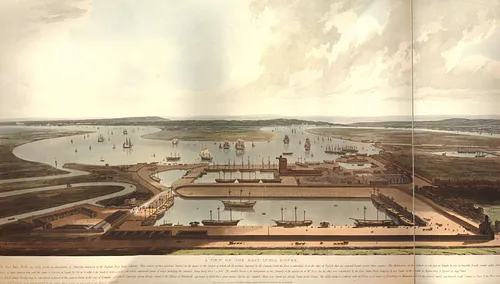
East India Dock / British Museum
trade oligarch
The East India Company was established under a Royal Charter in 1600 as a joint-stock trading company to exploit opportunities east of the Cape of Good Hope, and it was granted a trading monopoly. Above all, in order to carry out trade, the East India Company was allowed to “wage war “. Although the East India Company had no sovereignty over the areas in which it operated, it was allowed to exercise sovereignty in the name of the British (then British Empire) royal family and government. As the company grew stronger, that subtle distinction became more blurred, and that was the problem, and the source of its eventual demise.
The company created wealth for its shareholders through the global trade in spices, tea, textiles and opium. To protect its interests, the East India Company paid for its own private army in India, with headquarters in Bengal, Madras and Mumbai. It also long employed the corps of the British regular army. From the mid-18th century, beginning with Robert Clive’s (1725-1774) victory at the Battle of Plassey in 1757, these armies enabled the East India Company to recover from the decline of the Mughal Empire and the Indian states. The princes take over the territory. The East India Company then administered these territories, collecting taxes and duties to further enrich its shareholders and maintain its armed forces.
growing criticism
The East India Company tree had many enemies, not only the rival European trading companies and rulers of India, but also the British . The company has been widely criticized for its monopoly, harsh trade conditions and corruption. The scale of its trade was even large enough to cause a severe drain on British silver inventories. Its directors returned to Britain with vast new wealth, disrupting the established hierarchy of British society. These upstarts were dismissively called “nabobs” (nawab from the Indian term for rulers). The East India Company harmed the British wool trade by cheaply importing Indian-made textiles and was therefore unpopular. Later, Indians were equally disturbed by the importation of cheaper cotton fabrics from the big industrialized British factories. Last but not least, the East India Company swept away rulers who stood in its way, ruthlessly drained resources, and was absent in preaching to the peoples of its vast territories.
 The British Conquest of India circa 1857 / Simeon Netchev
The British Conquest of India circa 1857 / Simeon Netchev
In fact, the East India Company was a state within a state, and at the time it could even collect its own taxes and conduct trials through its courts. It is an entity with sovereign power, but it is not accountable to anyone but its shareholders. As the eminent Scottish economist and philosopher Adam Smith (1723-1790) pointed out in Causes of the Wealth of Nations , published in 1776, a company with a trading monopoly It is impossible for a sovereign state with power to rule fairly over all its subjects, and the two ideas are fundamentally incompatible. Parliament, while at one point more than 100 members were actually employed by the East India Company, also raised disturbing questions: Did the East India Company properly represent British interests abroad? Has its trade monopoly infringed on the potential growth of other UK companies?
step up supervision
Regulation Act 1773
Robert Clive’s return to England was the first ominous sign to the directors of the East India Company that their long journey to enrichment might be over. Clive’s affairs were investigated by Parliament in 1773 amid rumours that the former Bengal governor’s vast wealth had been acquired largely through corruption. In the end, Clive was honorably acquitted, but his proposal to Parliament to take over the East India Company was rejected. However, the company’s management has also been restructured. The Stewardship Act of 1773 brought changes. The government’s move was that, even though the East India Company had just paid its shareholders a 12.5% dividend, it still needed loans. The government appointed the first governor of the East India Company, Warren Hastings (1732-1818), and was governed by a board of four advisers. Other limitations are summarized here by M. Mansingh:
London’s board is required to hold elections every four years, with a quarter of its members changing each year, with shareholders with £1,000 or more of shares entitled to vote. In addition, directors are required to submit copies of all correspondence and dispatches with their agents (businessmen) in India to the Minister of State of the Royal Household, the Indian Secretary of State… A Supreme Court has been established in Calcutta to appeal only to His Majesty the King. (354)
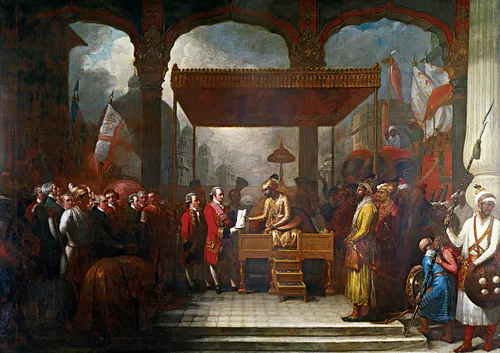 Robert Clive and Sha Alan / Benjamin West
Robert Clive and Sha Alan / Benjamin West
The British government gained at least some influence over military, financial and political decisions in the territories administered by the East India Company in its name. The British government began to take a greater interest in India, probably as a direct result of the loss of the North American colonies in 1783.
Hastings is particularly responsible for reducing corruption, primarily the practice of merchants indulging in private trade and accepting bribes from prospective contract holders. All private dealings of East India Company employees were prohibited and wages were raised. Hastings also tried to stop the worst abuses of Aboriginal people by local East India Company personnel.
Ironically, given his original assignment, Hastings himself was investigated for corruption upon his return to England in 1785. The Whig statesman Edmund Burke (1729-1797) severely criticized what he considered yet another “noble”. Worse, in Burke’s eyes, Hastings tarnished Britain’s reputation on the Indian and international stages by stealing on a rampant and acquiring all land and property in Bengal for the East India Company under “weird pretexts” (Wilson , 132). Key members of the British Parliament were again alarmed by the East India Company’s policies in India, with many trying to bring the company under greater scrutiny and control. However, when dealing with such a business giant, reform is not easy. Many MPs were still employed by the East India Company, or were shareholders (23% in the 1770s). In addition, the British monarchy disapproved of encroachment on private property. A pressing question at the time, however, was why this private company with private interests was allowed to act like a state without any constituency restraint or any judicial scruples. The atmosphere at the time was related to this. Political philosophers are now influencing British politicians with their ideas of the importance of individual liberty, governmental consent and just rule.
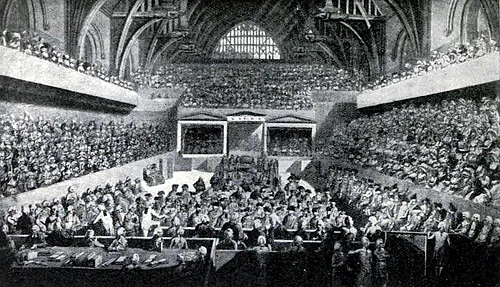 The Trial of Warren Hastings / Unknown Artist
The Trial of Warren Hastings / Unknown Artist
Indian Act 1784
The India Act of 1784 (often referred to as “Pitt’s India Act”, named after then Prime Minister William Pitt the Younger (1759-1806)) did restructure the top management of the East India Company again , Parliament has a representative on the Council of Full Control now in London. The India Act provides that the Board of Control “supervises, directs and regulates all conduct, actions and matters relating to the civil or military government or revenue of the British Territory of the East Indies” (Barrow, 63). For now, government intervention is still largely limited to oversight rather than regular intervention, but cumbersome bureaucratic procedures are tightening the grip on freedoms long enjoyed by the East India Company.
In 1787, Hastings was impeached by Parliament on charges of “serious crimes and misconduct.” Under the auspices of the House of Commons, the case is heard in Westminster Hall, where the public and the media can participate. Like Clive, Hastings was eventually declared free of any wrongdoing while in India. This time, however, the dark affairs of the East India Company were subject to very transparent and open scrutiny.
Charter Act 1813
The next wave of regulation came with the introduction of the Charter Act of 1813. From this point on, any new territories captured by the East India Company would be placed under the direct sovereignty of the British Parliament. In addition, the East India Company’s trade monopoly in India was terminated, and it had to end its ban on missionaries in its territory (though they needed a license to operate). Further controls emerged after the global economic collapse of 1825. The East India Company was in financial trouble and needed a bailout from the British government. Loans came quickly, but the question was further regulation of East India Company affairs. MPs are considering tougher action against the East India Company.
The broad questions before Parliament are whether companies should continue to exist, whether they should retain a monopoly on trade with China , and what role they should play if they are allowed to continue but not monopolize. (Barrow, 110).
As one congressman, James Silk Buckingham, pointed out in 1830, “The idea of handing over the political management of an empire of 100 million to a joint-stock society… (is) absurd. of.” (Dalrymple, 390)
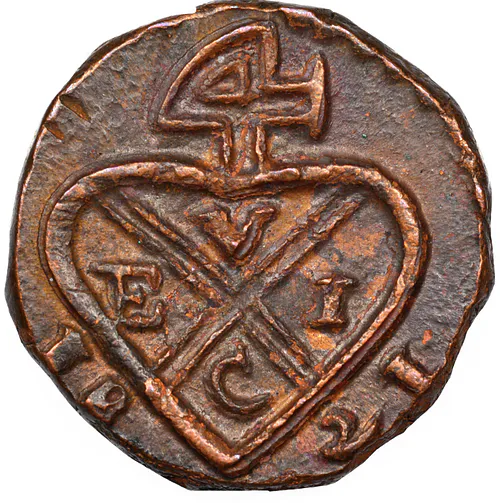 Copper Coins of the East India Company / Billjones94
Copper Coins of the East India Company / Billjones94
Charter Act 1833
The Charter Act of 1833 further tightened the rope around the neck of the East India Company. The Act removed all restrictions imposed by the East India Company on immigration to India. The company’s monopoly on Chinese trade has also ended. The judiciary – which lags badly in the trial of cases – is centralized, and new codes, which are regularly issued in the future, seek to homogenize the law and its application in India. Perhaps most importantly, the Charter expanded the Governing Council and gave it and the Governor-General the power to make legislation applicable to all inhabitants of the territory of the Council of Europe. In 1835, the company issued the first coin that was legal tender in all its member states (administrative regions) and the vassal states of India.
The new company coin symbolically established the dominance of Britain – not just companies – in India and created one of the conditions for the emergence of the national economy … It can be said that the issuance of the company rupee was also the prelude to the colonial state. (Barrow, 113-14)
These coins feature a portrait of King William IV of England (1830-1837).
Charter Act 1853
The Charter Act of 1853 again reduced the powers of the East India Company, so that the East India Company “was now little more than a governing body governing India, subject to the direction of the British government in matters of policy” (Spears, 148). This great trading company was nominally much like the British colonial administration elsewhere. It can collect taxes, has an army and a large civil service, all of which are monetaryly linked through its currency and rail and telegraph networks. In addition, British management and responsibility for India had become an accepted concept in the minds of the colonial administrators and the British Parliament. Governing the East India Company was a long and gradual process, but it ended in a climatic and bloody catastrophe.
Rebellion and Collapse
In 1857, the East India Company was shaken by the Indian Mutiny (or the First Indian War of Independence) when Indian soldiers in the East India Company army rebelled against their officers. The turmoil spread rapidly, affecting several royal families and even Indians of all classes. There were many reasons for the rebellion, from discrimination against Indian cultural practices to the fact that princes were not allowed to pass on their territories to their adopted sons, but the initial trigger came from Indian soldiers: they protested (among other things) that they were paid less than British soldiers much lower. At this time, the East India Company employed about 45,000 British soldiers and more than 230,000 Indian soldiers. Indian soldiers occupied important centers such as Delhi, but their lack of overall command and coordination meant that they could not overcome the superior resources of the East India Company, especially when the British government sent 40,000 troops to India.
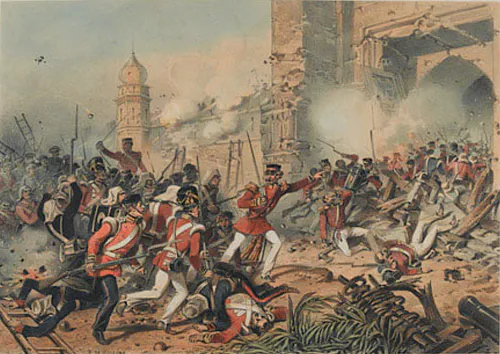 Retake Derry / Bequet Freres
Retake Derry / Bequet Freres
After the rebellion was quelled, the British believed that a colony as important as India could no longer be handed over to private companies. The Illustrated London News recorded this general sentiment in the following excerpt from July 1857:
What’s going on in India can totally set off the national alarm…our house in India is on fire. We have no insurance. To lose this house is to lose power, prestige and personality – a drop in status in the country… It is no longer a question of whether it is advisable for us to win India with the sword. Now that we have won it, we must keep it. (Barrow, 167-8)
According to the Government of India Act of August 2, 1858, the British Crown fully occupied the territory of the East India Company in India. Its army was incorporated into the British Army, while the navy was disbanded. The most aggressive and utterly ruthless private company of all time was effectively nationalized. Thus began what is known as British Raj in India. A new Minister of Indian Affairs is appointed and is directly accountable to Parliament, while the Governor-General represents the royal family. The Governor heads a cabinet of ministers who together oversee the day-to-day administration and justice. India is divided into Governor’s Districts, which in turn are divided into Lieutenant-Governor’s Districts. On June 1, 1874, after generously giving its shareholders more dividends for 16 years, Parliament formally dissolved the East India Company. In 1877, Queen Victoria was proclaimed Empress of India and the East India Company ceased to exist.

- ? Design: Blend Modes Explained
- ?Technology : Sound – Interactive Audio Visualization

? If you like Shyrism.News and would like to help me run it better:
- Forward to a friend or social network to invite to subscribe
- Book a spot in this sponsorship section
- Give me your appreciation in iDian /WeChat, welcome to remark your name and email address
- Click the link below and I will receive a modest sponsorship for every valid click of yours
❤️Thank you for your continued support!

Noom : Take the best route with Noom on your weight loss journey. It’s a mental behavior change program that educates and empowers you to make better choices for your health and personal goals. This science-based approach works for anyone, at home, on the go, or on vacation. Noom gives you the tools you need to make better choices, helping you change behaviors and develop healthy habits.


Did your friend forward this email or see it on a social platform? If you think it’s not bad, welcome to subscribe !
Shyrism.News is a bi-weekly selected newsletter covering new anecdotes, hot topics, cutting-edge technology and more about life and the future.
? Thank you for reading, welcome to reply and praise Shiqi.
?Past content | Discussion group | Personal blog

This article is reprinted from: https://shyrz.me/news-24-intrinsic-motivation/
This site is for inclusion only, and the copyright belongs to the original author.